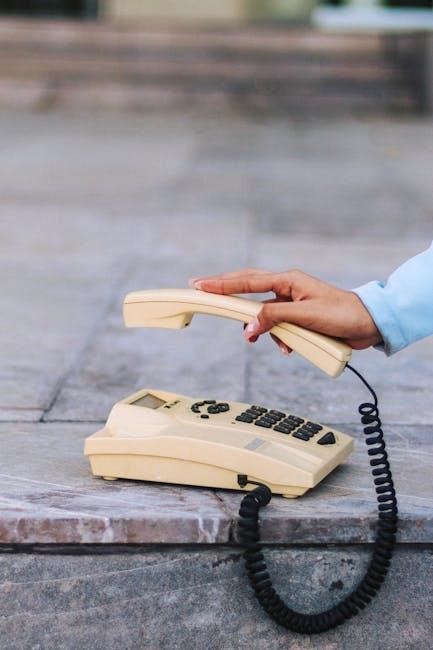The Cobra 29 LTD Classic is a professional CB radio renowned for its reliability and durability. This manual provides a comprehensive guide to installation, operation, and maintenance, ensuring optimal performance. Whether you’re a seasoned user or new to CB radios, this guide will help you maximize its capabilities effectively.

Features and Specifications
The Cobra 29 LTD Classic is a 40-channel CB radio with 4 watts AM power output. It features a tactile tuner, PA mode, and a built-in SWR meter for precise antenna tuning. Durable construction ensures long-lasting performance in various environments.
2.1 Overview of the Cobra 29 LTD Classic
The Cobra 29 LTD Classic is a professional CB radio designed for reliable communication, offering a robust feature set and durable construction. As a 40-channel transceiver, it operates on AM frequencies with a maximum power output of 4 watts, ensuring clear and strong signals. Known for its reliability, this model has been a favorite among truckers and CB enthusiasts for decades. The radio features a compact design with a user-friendly interface, including a tactile tuner and front-panel controls for easy access to key functions. Its built-in SWR meter simplifies antenna tuning, while the PA (Public Address) mode allows for external speaker connections. The Cobra 29 LTD Classic is also equipped with a noise-reducing circuit to minimize static and interference. With its timeless design and advanced capabilities, this radio remains a top choice for both professional and casual users. The manual provides detailed instructions for installation, operation, and maintenance, ensuring users can fully utilize its features and maintain optimal performance over time.
2.2 Key Features of the Radio
The Cobra 29 LTD Classic is equipped with a range of features that enhance its functionality and user experience. One of its standout features is the built-in SWR meter, which allows users to calibrate their antenna system accurately, ensuring optimal performance and preventing damage from mismatched loads. The radio also includes a PA (Public Address) mode, enabling connection to external speakers for amplified communication. Additionally, it boasts a noise-reducing circuit, which minimizes static and interference, providing clearer transmissions. The front-panel controls are intuitively designed, offering easy access to key functions such as channel selection, volume adjustment, and squelch control. The radio’s compact design makes it suitable for various installations, from trucks to recreational vehicles. Furthermore, the Cobra 29 LTD Classic supports external accessories, such as microphones and antennas, allowing users to customize their setup according to their needs. With its robust construction and advanced features, this radio is a reliable choice for both professional and casual users, ensuring dependable communication in diverse environments.

Installation Guide

Mount the radio securely in your vehicle, ensuring proper ventilation. Connect the power wires directly to the battery to avoid ignition noise. Install the antenna and perform SWR calibration for optimal performance. Avoid using lighter plug adapters to prevent potential electrical issues.
3.1 Mounting the Radio
Properly mounting the Cobra 29 LTD Classic is essential for reliable operation and safety. Choose a stable location in your vehicle, such as under the dashboard or on the floor, ensuring good airflow for ventilation. Use the provided mounting brackets to secure the radio firmly to prevent movement during driving. Avoid placing it near heat sources or sensitive electronics to minimize interference. Connect the power wires directly to the vehicle’s battery, using an appropriate fuse to protect the circuit. This setup helps reduce ignition noise, especially in modern vehicles with advanced computer systems. Ensure all connections are tight and insulated to avoid short circuits. For optimal performance, keep the radio away from direct sunlight and moisture. If installing in a truck, consider mounting it in a central location for easy access. Always refer to the manual for specific mounting recommendations and safety precautions to ensure a successful installation.
3.2 Antenna Setup and SWR Calibration
Proper antenna setup and SWR (Standing Wave Ratio) calibration are critical for optimal performance of the Cobra 29 LTD Classic. Begin by installing a high-quality CB antenna, ensuring it is securely mounted and properly grounded to minimize interference. Use an external SWR meter to check the antenna’s performance, as the built-in meter may not provide accurate readings. Connect the SWR meter in line with the antenna and follow the manual’s instructions to calibrate the system. A proper SWR reading (ideally 1:1) ensures efficient power transfer and prevents damage to the radio. If the SWR is too high, adjust the antenna’s length or position to achieve the correct reading. Improper calibration can lead to reduced range, overheating, or even damage to the radio’s final amplifier. For best results, perform the calibration on a flat, open surface with the vehicle’s ignition turned off. Always refer to the manual for specific instructions, as incorrect setup can void the warranty or cause permanent damage. Proper antenna setup and SWR calibration are essential for maximizing the radio’s performance and ensuring reliable communication.
Operational Guide
Mastering the Cobra 29 LTD Classic involves understanding its controls and features. Familiarize yourself with the channel selector, volume knob, and squelch control for clear communication. Use the RF gain to adjust sensitivity and minimize noise. Explore advanced features like PA mode for public address functionality and noise reduction settings to enhance clarity. Regularly check and adjust the antenna and SWR calibration for optimal performance. Refer to the manual for detailed instructions on utilizing these features effectively to ensure reliable and high-quality communication on the road.
4.1 Understanding the Controls
The Cobra 29 LTD Classic features an intuitive control layout designed for easy operation. The channel selector allows you to switch between 40 CB channels, while the volume knob adjusts the speaker’s audio level. The squelch control minimizes background noise by muting weak signals, ensuring clear communication. The RF gain adjusts the radio’s sensitivity, helping to filter out interference. Additionally, the PA (Public Address) switch enables external speaker functionality, useful for amplifying messages. The meter displays critical information like SWR (Standing Wave Ratio) and power levels, essential for optimizing antenna performance. Understanding these controls is key to maximizing the radio’s capabilities and ensuring reliable communication on the road. Proper adjustment of these settings can significantly improve transmission quality and reduce noise interference. Familiarizing yourself with the controls will help you operate the Cobra 29 LTD Classic efficiently and effectively in various driving conditions.
4.2 Using Advanced Features
The Cobra 29 LTD Classic offers several advanced features to enhance your CB radio experience. One of the key features is the SWR (Standing Wave Ratio) calibration, which ensures proper antenna performance. To calibrate, set the radio to SWR mode and adjust the antenna for a reading between 1.5 and 2.0. The RF gain control allows you to fine-tune signal sensitivity, reducing interference from nearby transmitters. For clearer communication, use the noise blanker to minimize static caused by engine noise or electrical interference. The PA (Public Address) feature enables you to broadcast through an external speaker, ideal for addressing a group. Additionally, the meter provides essential feedback on power output and SWR levels, helping you optimize your setup. To maximize performance, ensure the antenna is properly grounded and avoid using the cigarette lighter plug, as it can introduce ignition noise. By mastering these advanced features, you can achieve superior communication quality and customize the radio to suit your specific needs. Regularly checking and adjusting these settings will ensure optimal performance in various operating conditions.
Troubleshooting Common Issues
Common issues with the Cobra 29 LTD Classic include stuck meters, fuse failures, and static interference. For stuck meters, loosen set screws or replace the meter. Fuse failures may indicate overloaded circuits. Static can be resolved by adjusting RF gain and squelch settings. Refer to the manual for detailed solutions.
5.1 Diagnosing a Stuck Meter Movement
If the meter needle on your Cobra 29 LTD Classic doesn’t move when the radio is operational, it may indicate a stuck meter movement. This issue is often caused by the needle becoming jammed due to age or dust accumulation. To diagnose, gently shake the radio while observing the meter. If the needle remains stationary, it is likely stuck or the internal light may be burned out.

To address this, first, attempt to loosen the set screws located on the bottom and top of the meter. These screws are typically hidden under protective tape. Loosen them slightly to free the needle. If the screws are stubborn due to old thread lock compound, apply a small drop of acetone to loosen them. Be cautious not to remove too much tension, as this could damage the meter.
If these steps fail, consider replacing the meter entirely. Replacement meters for the Cobra 29 LTD Classic are widely available on platforms like eBay, often costing between $10 and $15. These replacements usually include a new light, making installation straightforward for those comfortable with soldering. Always ensure the new meter is compatible with your specific model to maintain proper functionality.
5.2 Dealing with Fuse Failures
Fuse failures in the Cobra 29 LTD Classic can occur due to power surges, electrical overload, or internal component issues. It is crucial to address fuse problems correctly to avoid damaging the radio. Never use a fuse with a higher rating than specified, as this can cause permanent damage or even destroy the radio. The fuse is designed to protect the device, and bypassing this protection can lead to severe consequences.
If the fuse blows repeatedly, it indicates an underlying issue that needs attention. Turn off the radio and unplug it from the power source before inspecting the fuse. Replace the blown fuse with one of the exact same rating, ensuring it matches the specifications outlined in the manual. If the problem persists, it is advisable to consult a professional technician who is familiar with CB radio electronics.
Attempting repairs without proper knowledge can result in further damage or safety hazards. Always prioritize caution and adhere to the manufacturer’s guidelines when dealing with electrical components. If unsure, contact Cobra Customer Service for assistance or refer to the troubleshooting section in the manual for additional guidance.
5.3 Resolving Static and Noise Problems
Static and noise issues are common challenges when using the Cobra 29 LTD Classic. These problems can arise from poor antenna connections, ignition noise, or RF interference. To address static, ensure the antenna is properly installed and grounded. A loose or corroded connection can significantly degrade signal quality.
Ignition noise, often caused by electrical interference from your vehicle’s ignition system, can be minimized by installing a noise filter or ferrite bead on the power cable. Additionally, routing the power cable away from ignition components can reduce interference. If using an external speaker, ensure it is properly shielded to prevent feedback.
For persistent static, adjust the RF gain and squelch controls to optimize signal reception. Grounding the radio chassis to the vehicle’s metal frame can also help eliminate noise. If issues persist, consider upgrading to a high-quality antenna or using an external noise-canceling device. Regular maintenance, such as cleaning connections and checking for loose wires, can prevent static and noise problems from occurring.

By addressing these common causes and implementing the suggested solutions, you can significantly improve the clarity and performance of your Cobra 29 LTD Classic CB radio.
5.4 Adjusting RF Gain and Squelch

Adjusting the RF gain and squelch controls on your Cobra 29 LTD Classic is essential for optimizing signal reception and reducing background noise. The RF gain control regulates the sensitivity of the receiver, allowing you to fine-tune the strength of incoming signals. To minimize interference, start by turning the RF gain control clockwise to reduce sensitivity, then adjust counterclockwise until the desired signal is clear.
The squelch control silences the speaker when no signal is present, eliminating static and noise. To set the squelch, turn the control counterclockwise until the speaker is silent, then adjust clockwise until it just begins to break through with the weakest signals. This ensures only strong, clear transmissions are heard.
For optimal performance, ground the radio chassis to the vehicle’s metal frame to reduce electrical interference. Additionally, using a high-quality antenna and ensuring proper SWR calibration can significantly enhance signal clarity. Regularly cleaning connections and checking for loose wires can also prevent static and noise issues. By carefully adjusting these controls, you can achieve a balance between signal strength and noise reduction, ensuring reliable communication with your Cobra 29 LTD Classic CB radio.
Repair and Replacement
Repairing the Cobra 29 LTD Classic involves replacing faulty components like meters or transistors. Use a soldering iron for installations. Replace the TIP120 transistor if it fails, and ensure fuses are rated correctly to avoid damage. Consult the manual for detailed replacement procedures and troubleshooting tips.

6.1 Replacing the Meter
Replacing the meter in your Cobra 29 LTD Classic is a straightforward process. If the meter is stuck or the light is burned out, it’s best to replace it entirely. New meters are widely available on platforms like eBay, often costing between $10 and $15, and they usually come with a replacement light. Installation requires basic soldering skills. Before replacing, you can attempt to unstuck the meter by loosening the set screws on the bottom and top, located underneath the tape. Gently backing off these screws may restore movement. If the screws are stubborn due to old thread lock compound, a drop of acetone can help loosen them. However, if the meter is damaged or the light is out, replacement is the most reliable solution. Always ensure the new meter is compatible with your Cobra 29 LTD Classic model. Consult the manual for detailed instructions and soldering tips to ensure a smooth replacement process. Proper installation is crucial to maintain the radio’s performance and accuracy.
6.2 Replacing the TIP120 Transistor
Replacing the TIP120 transistor in your Cobra 29 LTD Classic is essential if it fails, often indicated by overheating or increased static noise. Start by disconnecting the power source and grounding the radio to prevent static damage. Locate the TIP120 transistor on the circuit board, typically near the RF gain control. Desolder the transistor carefully using a soldering iron and remove it. Install the new TIP120, ensuring it’s securely mounted to the chassis for proper heat dissipation. Reconnect the soldered joints and test the radio to confirm the issue is resolved. If the resistor connected to the TIP120 is damaged, replace it with a 2-watt metal oxide resistor. This repair can resolve issues like RF noise and static, improving overall performance. Always refer to the schematic diagram for precise locations and connections. If unsure, consult a professional to avoid further damage. Proper replacement ensures reliable operation and maintains the radio’s functionality.

Optimizing Performance
Optimize your Cobra 29 LTD Classic by reducing noise interference and selecting the right antenna. Connect directly to the battery to eliminate ignition noise, especially in modern vehicles. Use a high-quality antenna for better signal strength and clarity. Regularly check and adjust the SWR for optimal performance. Ensure all connections are secure and free from corrosion. Proper grounding and using noise filters can further enhance reliability. Experiment with different antenna configurations to find the best setup for your environment. By following these steps, you can maximize the radio’s potential and enjoy clear, reliable communication on the road.
7.1 Reducing Noise Interference
Reducing noise interference is crucial for optimal performance of your Cobra 29 LTD Classic. Start by ensuring proper grounding of the radio and antenna system. A poor ground can lead to excessive static and noise. Use a high-quality noise filter or inline noise suppressor to minimize electrical interference from your vehicle’s ignition and electrical systems.
Avoid using the cigarette lighter plug for power, as it can introduce ignition noise. Instead, connect the radio directly to the battery using appropriate wiring. This helps eliminate potential interference from the vehicle’s electrical system. Additionally, ensure all connections are secure and free from corrosion.
Install a high-quality antenna with proper SWR calibration to reduce signal loss and noise. Consider using a noise-canceling microphone or external speaker to improve audio clarity. Adjust the RF gain and squelch controls to optimize signal reception and reduce background static.

Regularly inspect and replace worn-out components, such as fuses or resistors, to prevent internal noise. By following these steps, you can significantly reduce noise interference and enjoy clearer communication on the road.
7.2 Choosing the Right Antenna
Selecting the appropriate antenna is essential for maximizing the performance of your Cobra 29 LTD Classic. The antenna plays a critical role in transmitting and receiving signals, and a high-quality antenna ensures clear communication and optimal range. Magnetic antennas are a popular choice for their ease of installation and portability, while fiberglass antennas offer durability and improved performance in challenging environments.
Consider the specific needs of your setup, such as the type of vehicle and operating conditions. A properly tuned antenna with a low SWR (Standing Wave Ratio) is vital for efficient signal transmission and to prevent damage to the radio. Use an SWR meter to calibrate the antenna, ensuring it is resonant on the CB frequencies (26-27 MHz).
Avoid using low-quality or improperly matched antennas, as they can degrade performance and lead to signal loss. For permanent installations, a roof-mounted or trunk-lid antenna with proper grounding is recommended. Grounding the antenna ensures proper signal propagation and reduces interference.
By selecting the right antenna and ensuring proper installation, you can significantly enhance the performance of your Cobra 29 LTD Classic, achieving clearer communication and greater reliability on the road.
The Cobra 29 LTD Classic remains a trusted choice for professional CB communication, offering durability, reliability, and exceptional performance. This manual has provided a detailed guide to installing, operating, and maintaining your radio, ensuring you get the most out of its features. From understanding the controls to troubleshooting common issues, the information here equips you to handle your Cobra 29 LTD Classic with confidence.
By following the guidelines for antenna selection, SWR calibration, and proper maintenance, you can optimize your radio’s performance and enjoy clear, reliable communication. Whether you’re a seasoned user or new to CB radios, this manual serves as a valuable resource to enhance your experience.
Remember to refer to the official Cobra Electronics support resources for additional assistance and to stay updated on the latest tips and advancements. With proper care and use, your Cobra 29 LTD Classic will continue to deliver outstanding results, solidifying its reputation as a leader in CB radio technology.





